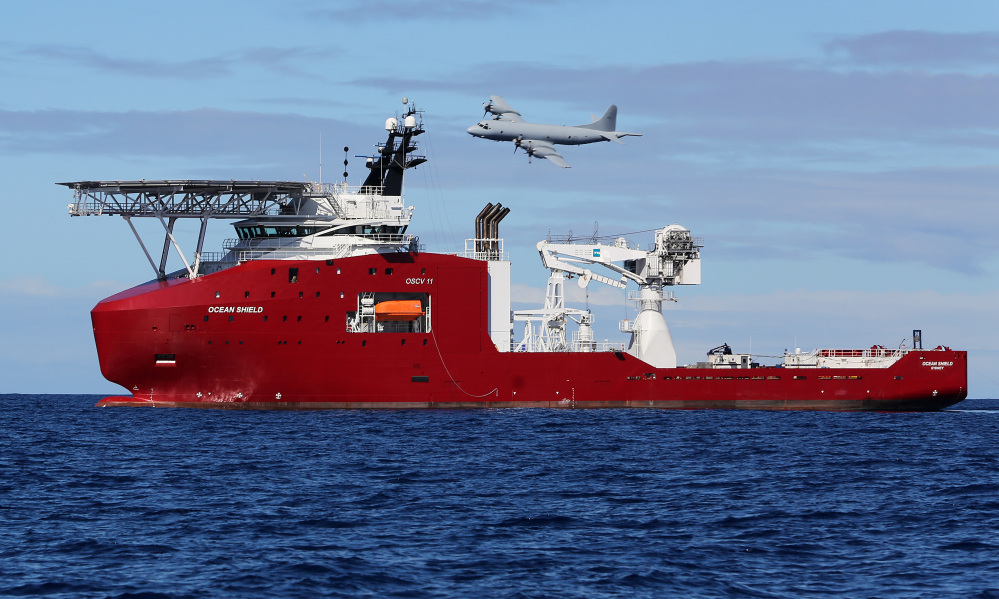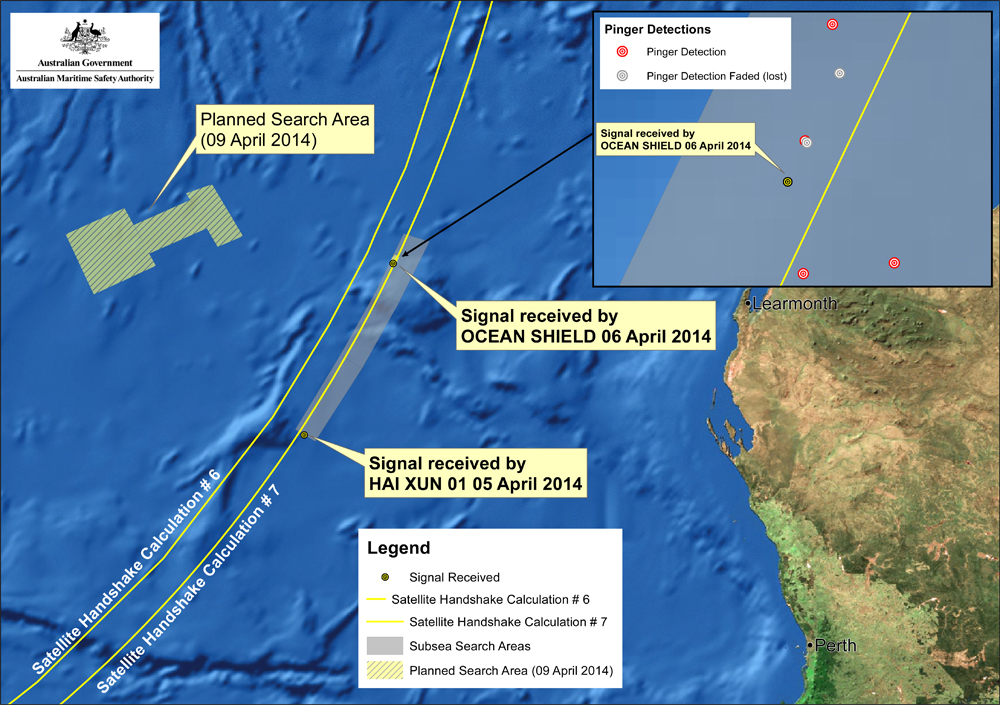PERTH, Australia — After a navy ship heard more signals from deep in the Indian Ocean, the head of the search for the missing Malaysian jetliner said Wednesday he believes the hunt is closing in on the “final resting place” of Flight 370.
The Australian vessel Ocean Shield picked up two signals Tuesday, and an analysis of two other sounds detected Saturday showed they were consistent with a plane’s flight recorders, or “black boxes,” said Angus Houston, the Australian official coordinating the search for the Malaysian Airlines jet.
“I’m now optimistic that we will find the aircraft, or what is left of the aircraft, in the not-too-distant future,” Houston said. “But we haven’t found it yet, because this is a very challenging business.”
Finding the flight data and cockpit voice recorders soon is important because their locator beacons have a battery life of about a month, and Tuesday marked one month since Flight 370 vanished March 8 en route from Kuala Lumpur, Malaysia, to Beijing with 239 people aboard.
If the batteries fail before the recorders are located, finding them in such deep water — about 4,500 meters, or 15,000 feet — would be difficult, if not impossible.
“I believe we are searching in the right area, but we need to visually identify aircraft wreckage before we can confirm with certainty that this is the final resting place of MH370,” Houston said. “For the sake of the 239 families, this is absolutely imperative.”
The search zone for Thursday had been narrowed to its smallest area to date — 57,923 square kilometers (22,364 square miles) of ocean that extended from 2,280 kilometers (1,417 miles) northwest of Perth, Houston’s coordination center said.
The Ocean Shield would continue to draw the pinger across the northern end of the zone on Thursday while the British ship HMS Echo and China’s Haixun 01 were using underwater acoustic equipment to search the southern end of the same zone.
The center’s statement on Thursday did not say whether any further sounds had been heard since Tuesday.
The hope expressed by Houston on Wednesday contrasted with the frustrating monthlong search for the Boeing 777, which disappeared shortly after takeoff in one of the biggest mysteries in aviation history. The plane veered off-course for an unknown reason, with officials saying that satellite data indicates it went down in the southern Indian Ocean off the coast of western Australia. The black boxes could help solve that mystery.
The signals detected 1,645 kilometers (1,020 miles) northwest of Perth by the Ocean Shield’s towed ping locators are the strongest indication yet that the plane crashed and is now at the bottom of the ocean in the area where the search is now focused.
A data analysis of the signals heard Saturday determined they were distinct, man-made and pulsed consistently, Houston said.
“They believe the signals to be consistent with the specification and description of a flight data recorder,” he said.
To assist the Ocean Shield, the Australian navy dropped buoys by parachute in a pattern near where the signals were last heard.
Royal Australian Navy Commodore Peter Leavy said each buoy will dangle a hydrophone listening device about 300 meters (1,000 feet) below the surface. The hope, he said, is the buoys will help better pinpoint the signals.
Houston acknowledged searchers were running out of time, noting the last two signals were weaker and briefer than the first pair heard Saturday, suggesting the batteries are failing. One lasted two hours and 20 minutes and the second lasted 13 minutes; those heard Tuesday lasted just 5 1/2 minutes and 7 minutes.
“So we need to, as we say in Australia, ‘make hay while the sun shines,'” Houston said.
The weakening of the signals also could indicate the device was farther away, U.S. Navy Capt. Mark Matthews said. Temperature, water pressure or the saltiness of the sea could also be factors.
Leavy said thick silt on the ocean floor also could distort the sounds and may hide wreckage from the eventual visual search.
Houston said a decision had not yet been made on how long to use the towed ping locator while knowing the beacons’ batteries will likely fail soon, saying only that a decision to deploy an unmanned submarine in the search was “not far away.”
“Hopefully in a matter of days, we will be able to find something on the bottom that might confirm that this is the last resting place of MH370,” he said.
When the ping locator’s use is exhausted, the unmanned sub will be sent to create a sonar map of a potential debris field on the seabed. The Bluefin 21 sub takes six times longer to cover the same area as the ping locator.
Matthews said the detections indicate the beacon is within about a 20-kilometer (12-mile) radius, equal to a 1,300-square-kilometer (500-square-mile) chunk of the ocean floor.
That’s like trying to find a desktop computer in a city the size of Los Angeles and would take the sub about six weeks to two months to canvass. So it makes more sense to continue using the ping locator to zero in on a more precise location, Matthews said.
The Bluefin sub’s sonar scans about to 100 meters and can “see” with lights and cameras only a few meters. Its maximum dive depth is 4,500 meters, and some areas of the search zone are deeper.
The audio search was narrowed to its current position after engineers predicted a flight path by analyzing signals between the plane and a satellite and investigators used radar data to determine the plane’s speed and where it may have run out of fuel.
Houston noted that all four of the pings detected since Saturday were near the site of a final, partial “handshake” signal revealed earlier in the investigation.
He also noted the surface search for any floating debris has been adjusted and intensified based on where the four pings were heard and where ocean currents might have caused objects to drift.
His center said on Thursday that Wednesday’s search over 75,427 square kilometers (29,121 square miles) of ocean “reported spotting a large number of objects.” But few had been retrieved by ships and none that had been recovered was suspected to be debris from the missing plane.
Up to 15 and 14 ships continued the search on Thursday, the same numbers as Wednesday.
Despite the challenges, those involved in the hunt were buoyed by the Ocean Shield’s findings.
“I’m an engineer so I don’t talk emotions too much,” Matthews said. “But certainly when I received word that they had another detection, you feel elated. You’re hopeful that you can locate the final resting place of the aircraft and bring closure to all the families involved.”
Send questions/comments to the editors.




Success. Please wait for the page to reload. If the page does not reload within 5 seconds, please refresh the page.
Enter your email and password to access comments.
Hi, to comment on stories you must . This profile is in addition to your subscription and website login.
Already have a commenting profile? .
Invalid username/password.
Please check your email to confirm and complete your registration.
Only subscribers are eligible to post comments. Please subscribe or login first for digital access. Here’s why.
Use the form below to reset your password. When you've submitted your account email, we will send an email with a reset code.